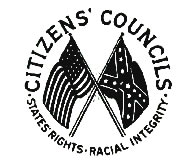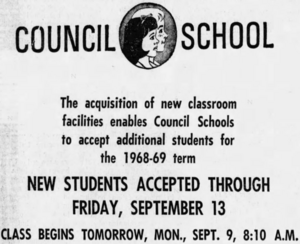Citizens' Councils facts for kids

Citizens' Councils logo
|
|
| Abbreviation | WCC |
|---|---|
| Successor | Council of Conservative Citizens |
| Formation | July 11, 1954 |
| Type | NGO |
| Purpose | Maintaining segregation and white supremacy in the South. |
|
Membership
|
60,000 (1955) |
|
Founder
|
Robert B. Patterson |
The Citizens' Councils were groups of people who believed in white supremacy and racial segregation. They were mostly found in the Southern states. These groups formed as a strong reaction against a big decision by the U.S. Supreme Court.
This decision, called Brown v. Board of Education, said that separating public schools by race was against the law. The first Citizens' Council started on July 11, 1954. By 1956, their name changed to the Citizens' Councils of America.
These groups had about 60,000 members across the South. Their main goal was to stop public schools from mixing students of different races. This was the main outcome of the Brown v. Board of Education ruling.
The Councils also tried to stop African Americans from registering to vote. In the South, most African Americans had lost their right to vote since the late 1800s. They also worked to keep public places like restaurants and buses separated by race during the 1950s and 1960s.
Members used different methods to achieve their goals. These included stopping people from buying from certain businesses, firing people from their jobs unfairly, spreading their ideas, and sometimes using threats or violence. By the 1970s, new laws about civil rights made the Councils much less powerful. Some of their members later formed a new group called the Council of Conservative Citizens in 1985.
Contents
History of the Citizens' Councils
How the Councils Started
In May 1954, the U.S. Supreme Court decided in Brown v. Board of Education that separating public schools by race was illegal. At that time, many Southern states had laws that kept schools and other public places separated by race.
The first Citizens' Council was created in Indianola, Mississippi. This happened two months after the Brown v. Board ruling. Robert B. Patterson, a farm manager and former football player, was seen as the main leader. More groups started in other Southern towns in the years that followed.
At this time, most Southern states had laws that forced racial separation in all public places. Even where laws didn't require it, Jim Crow customs made sure people were separated. From 1890 to 1908, many Southern states passed laws that made it very hard for most Black people to vote. This meant they lost their voting rights.
Even though civil rights groups won some legal cases, most Black people in the South still couldn't vote easily in the 1950s. They risked being punished if they tried to challenge racial separation. This included trying to sit where they wanted on buses or at lunch counters in stores.
Patterson and his followers formed the White Citizens Council to fight against the growing civil rights movement. They responded by using economic pressure and threats. The Regional Council of Negro Leadership (RCNL) was a civil rights group formed in 1951. It was based near Indianola.
Within a few months, the White Citizens Council gained many members who shared their beliefs. New groups formed across the Deep South. The Councils often had the support of important white people in communities. These included business owners, police, and even religious leaders. Businesses that were part of the Council sometimes worked together against people who registered to vote. The names of these voters were often published in local newspapers.
What the Councils Believed
Council members wrote a book called Black Monday. This book explained their belief that African Americans were not as good as white people. This idea was the reason they thought races should stay separate. One of the authors, Judge Tom P. Brady, wrote that if they didn't protest, they might as well give up.
Councils Across the Country
In August 1956, the Council's newspaper said there were groups in "at least 30 states." These included cities like Chicago, Cleveland, Detroit, and Los Angeles.
In 1964, the Councils put out ads in newspapers. One ad claimed that Abraham Lincoln was in favor of segregation. Another used quotes from Thomas Jefferson to say that nature had made clear differences between races.
This led to more interest in the Councils in places like Missouri and the Pacific Northwest. Also, the 1964 presidential campaign of George Wallace created interest in Indiana and Wisconsin. The Councils even hired people to start new groups outside the Deep South.
End of the Councils
By the 1970s, many white Southerners started to change their minds about racial integration. This was because new federal civil rights laws were passed in the 1960s. These laws made integration and voting rights stronger. Because of this, the White Citizens' Councils became much less active.
In 1985, some former members of the White Citizens' Councils started a new group. This group was called the Council of Conservative Citizens. It continued to promote similar ideas to the earlier Councils.
What the Councils Did
Spreading Their Message
Unlike the secret Ku Klux Klan, the White Citizens Council met openly. They were seen as trying to achieve the Klan's goals but in a more public way. From October 1954, the Council published a newsletter called The Citizens' Council. This later became a magazine in 1961 and was published until 1989.
From 1957 to 1966, the Citizens' Council had a radio and TV show called The Citizens Forum. On this show, they shared their ideas about segregation. Important politicians were sometimes interviewed on the show. Later, they even broadcast from African countries like Rhodesia.
The White Citizens' Councils also created racist children's books in the late 1950s. For example, some books taught that heaven was separated by race.
Council Schools
The White Citizens' Council in Mississippi worked to stop schools from integrating until 1964. As schools in some parts of the South started to mix students, the White Citizens' Council supported "council schools." These were private schools set up only for white children.
These private schools, also called segregation academies, were not covered by the ruling about public schools. Many of these private schools still exist today. The Council supported a system of twelve separate schools in Jackson, Mississippi.
Stopping People from Voting
Citizens' Councils tried to remove Black voters from election lists. Before this was made illegal in 1963, the Council used a law that allowed two voters to challenge another voter's registration. They used this to remove Black voters from the lists. In one area, 95% of Black voters were removed.
The Council also gave out booklets to white voting officials. These booklets explained how to prevent Black people from registering to vote. They also required officials to attend meetings about stopping Black registration and removing Black voters.
Political Power
Many important state and local politicians were members of the Councils. In some states, this gave the organization a lot of power over state laws. In Mississippi, a group called the Mississippi State Sovereignty Commission was created. It was supposed to help the state's image and bring in businesses.
However, this state agency, funded by all taxpayers, gave money to the segregationist Citizens' Councils. Some years, they gave as much as $50,000. This agency also shared information with the Councils that it had gathered by spying on civil rights activists. For example, Dr. M. Ney Williams was both a director of the Citizens' Council and an advisor to Mississippi Governor Ross Barnett.
Governor Barnett was a Council member, as was Jackson mayor Allen C. Thompson. In 1955, during a bus boycott in Montgomery, Alabama, all three members of the city commission announced they had joined the Citizens' Council.
In Louisiana, the Citizens' Council started as a part of a legislative committee that wanted to keep segregation. Leaders of the original Citizens' Council in Louisiana included State Senator William M. Rainach and U.S. Representative Joe D. Waggonner Jr..
On July 16, 1956, the Louisiana State Legislature passed a law forcing racial separation in almost every part of public life. This happened because of pressure from the White Citizens Councils. Governor Earl Long signed the bill into law.
The law said that all people were not allowed to have mixed-race dancing, social events, or sports. It also said that white and Black people had to use separate seating and facilities. It made it illegal for white people to use facilities set aside for Black people, and vice versa.
In 1964, most Council members were said to support presidential candidate Barry Goldwater. News reports also showed that George Wallace received support from groups like the White Citizens' Councils during his 1968 presidential campaign. While Wallace didn't openly ask for their support, he also didn't refuse it.
See also
 In Spanish: Citizens' Council para niños
In Spanish: Citizens' Council para niños
- Racism in the United States
- Racism against Black Americans
- Civil Rights Movement
- States' rights



